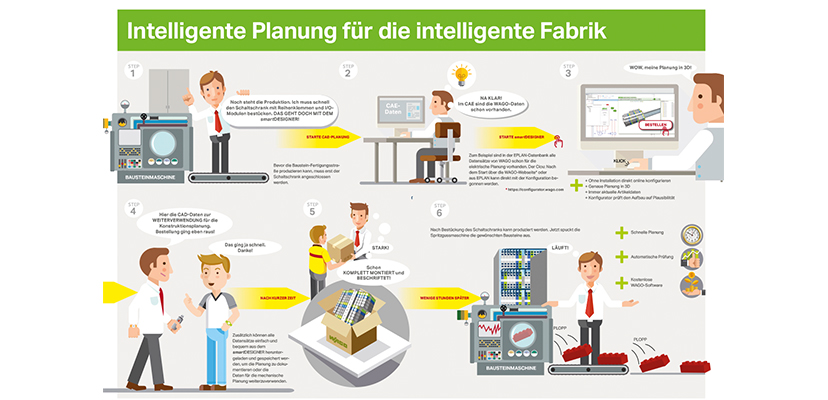


Ordering and production processes are being increasingly digitized. An integrated system provides transparency from the order to the finished product.
PLM, ERP, MES – In the industries of the future, software technologies like these will be increasingly used to digitize and automate ordering and production processes. No business headed for smart factory technology can afford to be without them. The people at WAGO, based in Minden, have realized this, too. As early as 2000, the company began to comprehensively digitize its value added chain. Today, the manufacturer of electrical interconnections and automation technology not only saves on paper, it also decides when and where orders will be processed in a fully automated manner. This is especially relevant, not only when shipping in-stock items, but also when producing custom products for customers.
When systems manufacturer Andreas Muth designs the circuits for his packaging machines, he relies on smartDESIGNER from WAGO. He can start configuring them immediately after launching the software on the WAGO website or from EPLAN. Muth finds that the most current product information is always available online including: specific items, data sheets and product pictures, as well as downloads of CAE and CAD data. With just a few mouse clicks, the designer can put transfer terminal strips and I/O modules, when he can then assemble later in a way that is affordable, space-saving, and functional. An automated plausibility check guarantees that the design of Muth’s support rails is error-free. He then exports his design, including the parts lists, photos of the products used, and a 3D model, and sends the order to WAGO.
Transparency instead of a black box
From Muth’s point of view, once his order arrives at WAGO, it enters a so-called black box. However, where his view is obscured, the people at Minden can see everything clearly. Production processes are completely software-based and transparent from start to finish, at least, for every employee who needs access to the ordering and production processes.
Computer-based systems were introduced early into the product development process at WAGO; they are used in manufacturing and for product data management because the rapidly increasing product range, the competitive market, and the company’s global presence place huge demands on the development and production departments. In addition, the company’s high quality standards have led to a large vertical manufacturing range and the need to develop and produce their own equipment and tools. The Teamcenter product lifecycle management system (PLM) was introduced when the company entered the new century. It enabled integral control and management of product data and processes across the entire product lifecycle. “We made optimizing the complete process chain a priority – from development to manufacturing,” explains Michael Burmester, who heads the process and product data management division at WAGO. He adds, “It was important to us to lay a good foundation so that the production processes could be designed to be viable into the future. Even back then, it was clear that we would have to digitize all of our processes and information in order to do this.”
Digital, fast, and flexible
Once WAGO has received Muth’s order, the data is sent to the PLM system for processing. This adds relevant information to the configured product – for example, ETIM and eCl@ss classification data, and information on the packaging type and unit. This step also determines when and where Muth’s order will be processed. This decision is based no only on the requested delivery date, but also, naturally, on logistical data, like delivery routes, shipping times, and the capacities of the production equipment at the facility in question. As Muth needs the finished terminal strips at his factory in Berlin within a week, they will be manufactured by WAGO in Sondershausen in Thuringia.
The order is subsequently further processed by the enterprise resource planning system (ERP). WAGO uses SAP for this purpose. This generates a manufacturing order and triggers the production and logistics processes. SAP and the manufacturing execution system (MES) enable control and monitoring of production in real time. All relevant operating and machine data as well as staffing information is collected for this purpose, and any additional data that would have a real-time impact on the manufacturing process, are also input.
WAGO’s completely digitized process chain and the real-time capabilities of the system allow for subsequent changes to an order until just prior to the point of manufacture. This is a great advantage for Muth, the system designer, who realizes the following day that he selected the wrong internal system supply module. To correct this, he simply revises his configuration in smartDESIGNER and re-submits the data to WAGO.
Well positioned for the future
WAGO has continuously expanded and improved its ordering and production processes since launching them in 2000. One milestone on the road to the smart factory was the introduction of SAP in 2015 at all German production sites. “We are really pleased with what we have achieved thus far,” states Burmester, and adds, “we have already come close to our vision. However, there are still a number of small tweaks that we have to make to streamline the processes and become digital down to our fingertips.” On the international level, WAGO is poised to take another big step; they are about to switch to SAP as their global ERP system.
Even with the cutting edge, automated processing system, Muth’s carrier rails are, in the end, a mixture of machine production and traditional, manual labor. While the terminal blocks and I/O modules are manufactured on modern production lines, the individual assembly of the components and application of the marking remains complex due to the number of possible configuration options. Therefore, these steps are deliberately carried out manually. Yet even this manufacturing area has eliminated paper dockets. Instead, the staff always see the most up-to-date version of the order on their workstation screens, so that know how to populate the specific carrier rail. Incidentally, the 3D graphic that they see now is the same one that Muth modeled while working in smartDESIGNER earlier.
Text: Simone Brinkmann-Tewes und Julia Ockenga WAGO
Photo: Fotolio, WAGO